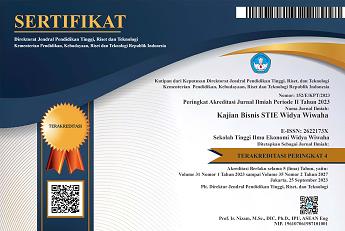CORPORATE GOVERNANCE : DEMOGRAFI ORGANISASI, KARAKTERISTIK DEWAN DAN KINERJA PADA PERUSAHAAN YANG TERMASUK LQ 45 DI BURSA EFEK INDOENESIA
DOI:
https://doi.org/10.32477/jkb.v25i1.142Keywords:
organization demography, the characteristics of the board of direction, accounting performanceAbstract
The dimensions of good corporate governance can certainly affect the condition of the company, including LQ 45 Company. The LQ 45index is the value of the market capitalization of 45most liquid stocks and has a large capitalization value which is theliquidationindicator. LQ 45 index uses 45 selected stocks based on stock trade liquidity and adjusted every six months (every early February and August). LQ 45 index only consists of 45 selected stocks of various selection criteria, so it will be consisting of stocks with high liquidity and market capitalization. Thus, it is understandable that companies included in LQ45 areones with a good performance. However, theinfluence of good corporate governance implementation is not yet known through the demographic organization and characteristics of the board toward the company performance. Therefore, it is necessary to conduct further research related to good corporate governance in LQ 45 companies in the aspect of organization demography and the board’scharacteristics. This research was conducted to determine the relationship between organization demography and the characteristics of the board of directors toward the accounting performance (ROA and ROE) in LQ 45. Statistical analysis in this study is conducted by multiple linear regressions. The regression equation in this study is formulated into a model equation, as in the hypotheses and research framework model. In this study, 2 testing of multiple regression analysis were conducted. The regression equation for the first test is as follows. The results showed that: (1) there is a significant effect of organization demographyto the characteristics of the board, (2) there is a significant influence of the characteristics of the board on the performance of accounting, (3) there is no significant influence of the age of the organization to the characteristics of the board, (4 ) there is a significant positive influence of the size of the organization on the characteristics of the board, (5) there is no significant influence of the length of time the organization is listed on the Stock Exchange (BEI)to the characteristics of the board, (6) there is a significant positive influenceof the size of the board to the accountingperformance, (7) There is no significant influence of the CEO duality to the accountingperformance, (8) there is no significant influence of the independence of the CEO on the accountingperformance, (9) there is no significant influence of gender on the accounting performance
References
Ahmed, Anwer S. dan Duellman, Scott. (2007), “Accounting Conservatism and Board of Director Characteristics: An Empirical Analysis”, Journal of Accounting and Economics, 2007, Vol. 43, Issue 2-3, pp. 411-437.
Alchian, A.A (1965), Some Economics of Property Rights, Economic Forces at Work Indianapolis: Liberty Press.
Arikunto, Suharsimi (2010), Prosedur Penelitian, Jakarta: Rinneka Cipta.
Bathula, Hanoku. (2008), “Board Characteristics and Firm Performance: Evidence from New Zealand”, Thesis, Faculty of Business AUT University New Zealand.
Beasley, Mark S. (1996), “An Empirical Analysis of the Relation Between the Board of Director Composition and Financial Statement Fraud”, The Accounting Review, Vol. 71 No.4. October, pp. 443-465.
Carol, Glenn N. & Hannan, Michael T (2000), “The Demography of Corporations and Industries”, New Jersey: Princeton.
Cheung, S.N.S (1970), “The Structure of A Contract and the Theory of Non-exclusive Resource”. Journal of Law and Economics, Vol. 17, pp. 34-51.
Cheung, S.N.S (1983), “The Contractual Nature of the Firm”, Journal of Law and Economics, Vol. 25, pp 118-131.
Coase, R.C (1937), “The Nature of the Firm”, Economica, Vol 2, pp. 25-34.
Coase, R.C (1960), “The Problem of Social Cost”, Journal of Law and Economics, Vol. 4, pp. 213-228.
Demsetz, H (1964), “The Exchange and Enforcement of Property Rights”, Journal of Law and Economics, Vol. 9, pp. 97- 109.
Hall, Steven C.; Agrawal, Vipin; & Agrawal; Pushpa (2013), “Earnings Management and the Financial Statement Analyst”, Accounting and Financial Research, Vol. 2, No. 2; 2013, pp. 105-111.
Hambrick, D.C., dan P. A., Mason (1984), “Upper Echelons: the Organization as a Reflection of its Top Managers”, Academy of Management Review, Vol. 9, pp. 193-206.
Ibarra, H. (1992), “Homophily and Differential Returns: Sex Differences in Network Structure and Access in Advertising Firm”, Administrative Science Quarterly, Vol.37, pp. 422-447.
Indrianto, Nur dan Supomo, Bambang (2002), Metodologi Penelitian Bisnis Untuk Akuntansi dan Manajemen, Yogyakarta: BPFE UGM.
Jensen, M.C. (1993), “The Modern Industrial revolution, Exit, and the Failure of Internal Control System”, Journal of Finance, Vol. 48, July, pp. 831-880.
Klapper, Leora F. & Love, Inessa (2000), “Corporate Governance, Investor Protection, and Performance in Emerging Markets”, Ideas Papper.
Koufopoulos, D. N; Gkliatis, I. P.; & Seitanidi, M (2013), “Does Organisational Demography Affect Board Characteristics? Findings From the Manufacturing Sector in Greece”, International Journal of Accounting Management Review.
La Porta, R., F. Lopez-de-Silanez, and A. Shleifer (1999), “Corporate Ownership around the World”, Journal of Finance, Vol. 54, pp. 1116-1132.
La Porta,R., F. Lopez-de-Silanez, A. Shleifer, and R. Vishny (1997), “Legal Determinants of External Finance”, Journal of Finance, Vol. 52, pp. 2112- 2223.
La Porta,R., F. Lopez-de-Silanez, A. Shleifer,and R. Vishny (1998), “Law and Finance”, Journal of Political Economy, Vol, 106, pp. 321-339.
Peters, George T. & Bagshaw, Karibo B. (2010), “Corporate Governance Mechanisms and Financial Performance of Listed Firms in Nigeria: A Content Analysis”. Global Journal of Contemporary Research in Accounting, Auditting, and Business Ethics, Vol 1, pp. 103-128.
Pfeffer, Jeffrey (1983), “Organizational Demography”, Research in Organizational Behavior, Vol. 5, pp. 299-357.
Prastowo, Dwi & Rifka Juliaty (2008), Analisis Laporan Keuangan, Yogyakarta: UPP AMP YKPN.
Sugiyono (2011), Metode Penelitian Kuantitatif, Kualitatif, dan R&D. Bandung: Alfabeta.
Tehranian, Hassan, Cornett Marcia M., Marcuss Allan J., & Saunders, Anthony (2006), Earnings Management, Corporate Governance, and True Financial Performance. http://papers.ssrn.com/
Ujiyantho, Muh. Arief dan Pramuka, Bambang Agus (2007), “Mekanisme Corporate Governance, Manajemen Laba Dan Kinerja Keuangan (Studi pada Perusahaan Go Publik Sektor Manufaktur)”. Simposium Nasional Akuntansi X, IAI.
Yermack, D (1996), Higher Market Valuation of Companies With A Small Board of Directors. Journal of Financial Economics Vol. 40, pp. 185-211.









